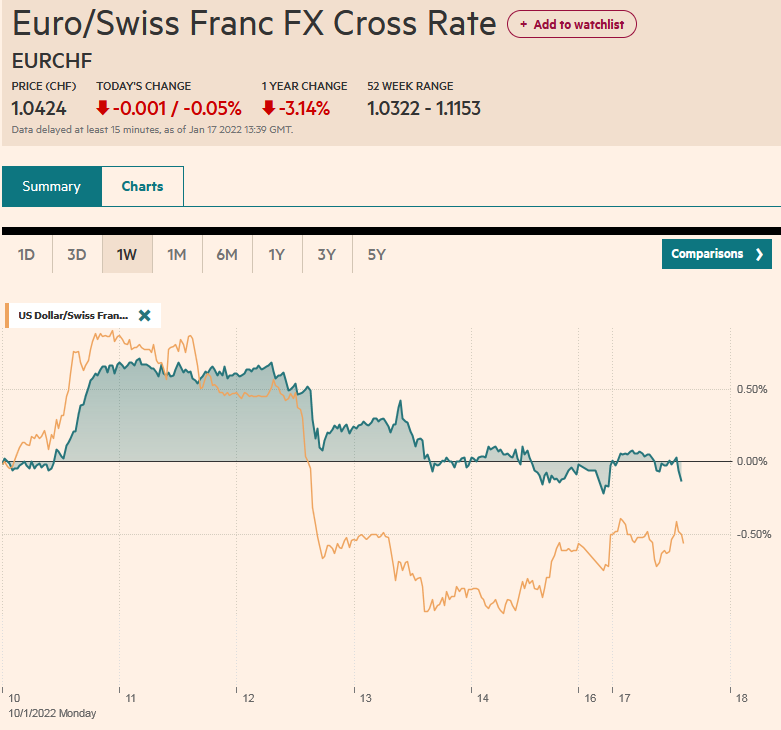Overview: Russia’s invasion of Ukraine and the global response is a game-changer, as Fed Chair Powell told Congress yesterday. The UK-based research group NISER estimated that world output will be cut by 1% next year or trillion, and global inflation will be boosted by three percentage points this year and two next. The recovery in US stocks yesterday may have helped lift Asia Pacific shares today (China and India are notable exceptions). However, Europe’s Stoxx 600 is softer as are US futures. The 10-year US Treasury is hovering around 1.86%, while European yields are mostly 3-6 bp higher. The US dollar remains strong. The Canadian and Australian dollars have been among the most resilient. CAD traded at its best level since late January but is now
Topics:
Marc Chandler considers the following as important: 4.) Marc to Market, 4) FX Trends, Australia, Bank of Canada, China, Currency Movement, Featured, Hungary, Japan, Mexico, newsletter, PMI, Turkey, USD
This could be interesting, too:
Nachrichten Ticker - www.finanzen.ch writes Die Performance der Kryptowährungen in KW 9: Das hat sich bei Bitcoin, Ether & Co. getan
Nachrichten Ticker - www.finanzen.ch writes Wer verbirgt sich hinter der Ethereum-Technologie?
Martin Hartmann writes Eine Analyse nach den Lehren von Milton Friedman
Marc Chandler writes March 2025 Monthly
|
Overview: Russia’s invasion of Ukraine and the |
|
| However, Europe’s Stoxx 600 is softer as are US futures. The 10-year US Treasury is hovering around 1.86%, while European yields are mostly 3-6 bp higher. The US dollar remains strong. The Canadian and Australian dollars have been among the most resilient. CAD traded at its best level since late January but is now consolidating those gains in the aftermath of yesterday’s 25 bp rate hike and the risk-on move. The Australian dollar is at its best level since mid-November. Major European currencies, except the Swiss franc, and emerging market currencies are bearing the brunt. Even the Hungarian forint is finding little traction after the central bank hiked the one-week deposit rate by 75 bp instead of the 50 bp that were expected. Gold is in a narrow $13 range mostly below $1935. Last week’s peak near $1975 has not been approached and this week’s high is around $1950. April WTI poked briefly above $116.50 a barrel and is still firm. US natgas prices are up another 1.5% after climbing 8% in the past two sessions. |
|
| Europe’s natgas benchmark has reversed early gains and is off about 7.5% after jumping more than 65% over the past two sessions. Industrial metals, from iron ore, copper to zinc and aluminum are extending their rallies. May wheat prices are up 4.5% to bring this week’s gain to around 25%.Asia PacificChina’s Caixin service PMI was stronger than expected but still falling to 50.7 from 51.4. The composite was unchanged at 50.1, suggesting little momentum. Reserves and trade are due next, followed by CPI next week. Both PPI and CPI are expected to have slowed. Japan’s final PMI service |
|
| The report underscores the challenge to the world’s third-largest economy this quarter. However, it appears to be largely a result of Covid and the social restrictions. This could set the stage for a recovery in Q2.Australia’s final service and composite PMI were revised higher, and the January trade surplus was much larger than expected. The final service PMI stands at 57.4, up from 56.4 of the preliminary estimate and 46.6 in January. The composite PMI is at 56.6. The flash reading put it at 55.9 after January’s 46.7 final report. The January trade |
|
| surplus swelled to A$12.9 bln from A$8.8 bln in December. The January surplus was about a third larger than the median forecast in Bloomberg’s survey, helped by an 8% rise in exports in the month, while imports fell by 2%. The one disappointing report today from down under, came from the January building approvals, which tanked by almost 28%. Economists (Bloomberg survey) saw a 3% decline.The dollar is trading near two-week highs against the yen around JPY115.80. The JPY116.00 area offers initial resistance and a $450 mln option expires there today. Th |
|
| e high seen in January and retested in February was JPY116.35. Support is now pegged in the JPY115.35-JPY115.50 area. The Australian dollar has risen to its best level, almost $0.7325, since mid-November. The 200-day moving average comes in today near there and it last was tested late last October. It has not closed above it since last June. Note that the (61.8%) retracement of its losses since that October high is near $0.7330. The Chinese yuan has been confined to yesterday’s range (~CNY6.3110-CNY6.3225). The PBOC fixed the dollar at CNY6.3016, while expectations (Bloomberg survey) were for CNY6.2997. The PBOC has not set the dollar’s reference rate below |
|
| CNY6.30. Note that Chinese bond futures fell to their lowest level in nearly four months as some have second thoughts about the aggressiveness of the expected easing.EuropeThe financial choke hold on Russia continues to tighten. MSCI and FTSE are dropping Russian stocks, which are untradable given the sanctions. Moody’s and Fitch slashed Russia’s rating to junk. Some oligarch’s assets have been confiscated. The number refug |
|
| ees fleeing Ukraine is approaching a million. Reports suggest that the US held off a scheduled ICBM test to avoid any possible misinterpretation.The German and French flash service and composite PMIs were revised lower in the final estimate, while Italy, and especially Span, surprised on the upside. Of note Italy and Spain’s service PMI recovered back above the 50 boom/bust level that had been violated in January. The aggregate service PMI rose to 55.5 from January’s 51.1, a little below the flash estimate of 55.8. The composite PMI is also at 55.5, n |
|
| ot the 55.8 of the preliminary estimate, and better than the 52.3 seen in January.The UK follows the similar pattern seen in Germany and France. The flash PMI was revised lower, but the final reading still was an improvement from January. The UK service PMI stands at 60.5, not 60.8, after January’s 54.1. The composite PMI is at 59.9. The flash reading put at 60.2 after January’s 54.2.Turkey’s CPI accelerated to 54.44% from a year ago, up from 48.69% in January. The month-over-month increase was 4.81%. The median in Bloomberg’s survey called for a 3.75% increase. The core rose to 44.05% from 39.45%. Producer prices jumped another 7.22% in the month of February after a 10.45% increase in January. The year-over-year pace accelerated to 105.01% from 93.53%. Elsewhere, we note that Hungary’s central bank hiked the key one-week deposit rate to 5.35% from 4.60%. A 50 bp hike was expected and a 75 bp move was delivered. It is the largest move since the one-week deposit rate as activated for policy purposes in Q4 21. The euro is spending more |
|
| Yesterday it has briefly dipped below $1.1060. Today’s low so far has been just above $1.1070. There is an option for almost 900 mln euros at $1.11 that expires tomorrow. Sterling has fared better than the euro but seems range-bound between $1.3270 and $1.3440. Late in the European morning, it is trading around $1.3380. Two BOE officials have been quoted on the news wires. Deputy Governor Cunliffe warned of downside risks to growth while Tenreyro noted the upward risks to inflation. The intraday momentum indicator favors a test on the highs.AmericaFed Chair Powell testifies in the Senate today. His prepared remarks are the same, even if the questions are different. Still, the Chair got good reviews from yesterday’s measured comments and clear endorsement of a 25 bp hike later this month, while reserving the right to accelerate later if needed. At the same time, the 2-10-year curve flattened further yesterday, dipping below 35 bp. There is a full slate of US |
|
| The Q4 productivity and unit labor costs are derived from Q4 GDP, but it is notable that despite the worries that higher wages were spurring inflation, unit labor costs, which wages, benefits and output rose by 0.3% in Q4, will show that the final estimate today is expected to confirm it. The US also sees the final Markit services and composite PMI and the ISM services. January factory orders and the final durable goods reading are also due. Economists may use the ISM data to help fine-tune forecasts for tomorrow’s jobs report. The median forecast (Bloomberg’s survey) has crept a little higher to 418k from 400k.The Bank of Canada delivered the first hike in sequence that will run well into next year. The 25 bp hike lift the bank rate to 0.50%. There was no new forward guidance on the balance sheet strategy, which took many observers by surprise. Perhaps it is the way the central bank could acknowledge the uncertainty spurred by Russia’s invasion of Ukraine. Governor Macklem speaks today and holds a press conference, where more insight into the central bank’s thinking is likely.Mexico’s central bank cut this year’s GDP forecast to 2.4% from 3.2% A little was pushed into next year (now seen at 2.9% rather than 2.7%) but some is simply lost. It expects CPI to peak shortly and head back to 4% toward the end of the year. That still seems optimistic. Meanwhile, Deputy Governor Heath indicated he suggested a 75 bp hike last month but voted for the 50 bp move. The US dollar set the high for the year last week near CAD1.2880. Yesterday, it fell below the CAD1.2650-CAD1.2660 shelf that had been forged last month and settled on its lows slightly below CAD1.2630. Follow-through selling saw the greenback slip below CAD1.2590 in early European turnover. However, it snapped back to almost CAD1.2640. Old support may now act as resistance. The US dollar rose slightly above last month’s high yesterday against the Mexican peso (~MXN20.7850) but did not sustain the momentum and fell back to around MXN20.58. It is inside yesterday’s range today but looks poised to rechallenge the highs. The year’s high, set in late January, was near MXN20.9150. |
Tags: #USD,Australia,Bank of Canada,China,Currency Movement,Featured,Hungary,Japan,Mexico,newsletter,PMI,Turkey






